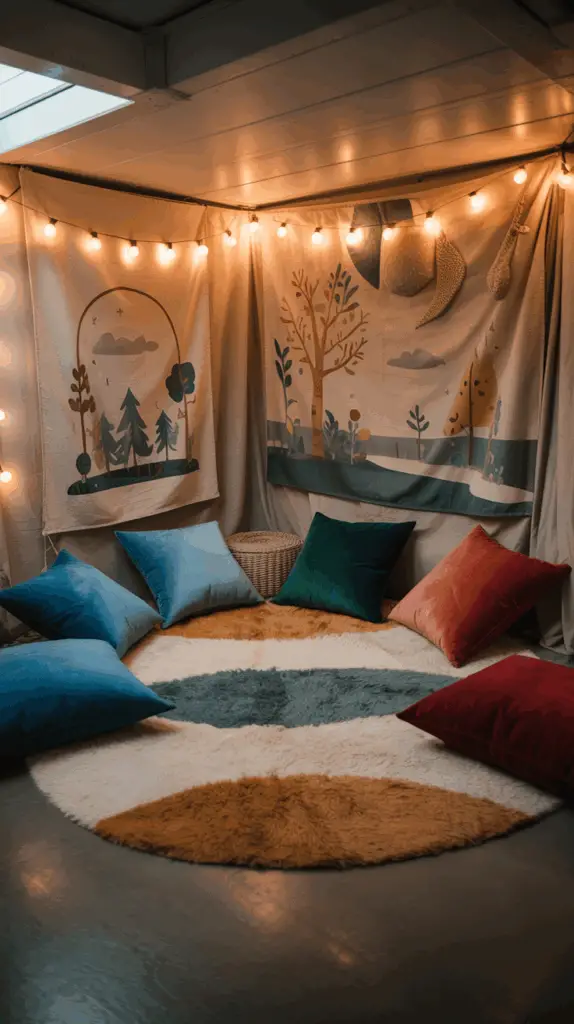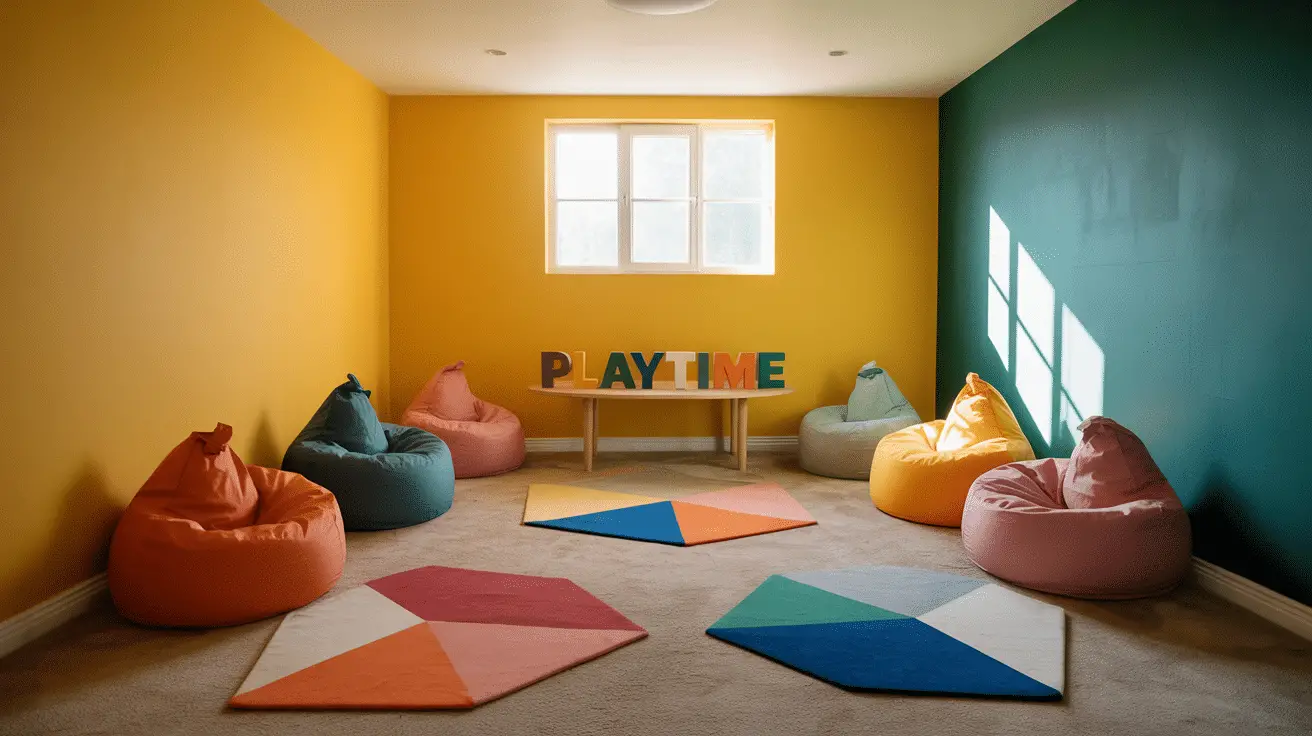Cozy and Colorful Basement Playroom Ideas That Kids Will Love
Table of Contents
Introduction
Imagine walking into a basement that’s no longer a cold, dark, underused space but instead a vibrant, cozy playroom where your kids can unleash their creativity, play freely, and spend hours making memories. Transforming your basement into a colorful playroom is not only a way to maximize your home’s square footage but also a chance to create a joyful environment that will excite your little ones.
While basements are often seen as a less-than-ideal space for living areas, with the right approach, they can become a kid-friendly haven. The key lies in designing a room that’s both functional and fun. From soft furnishings to bold colors and creative storage solutions, a well-designed playroom can provide a safe and inspiring space for kids to grow, explore, and play.
In this blog, we’ll dive into several cozy and colorful basement playroom ideas that kids will love. Whether you’re looking to create a themed play area, incorporate creative storage solutions, or simply infuse some color and comfort into your basement, these tips will help turn your vision into reality. With practical ideas, real-life examples, and expert advice, you’ll learn how to create a playroom that’s perfect for both kids and parents.
Embrace Bold and Fun Colors
When it comes to designing a basement playroom, color is everything. Bold, vibrant colors not only inject energy into a space but also help to define the room’s mood. Kids are naturally drawn to bright colors, which can spark their imagination and create a dynamic environment for play.
Start by selecting a primary color palette for the room. You can go with playful hues like cheerful yellows, vibrant blues, or rich greens. If you want a more sophisticated look, consider pairing these colors with neutral tones such as soft grays or whites to balance out the intensity. Accent walls are a great way to add visual interest. For example, a feature wall in a deep teal or playful pink can add a pop of color without overwhelming the space.
Incorporating colorful furniture, rugs, and accessories further enhances the playful vibe. Try to mix and match different colors for a more eclectic, energetic look. A combination of primary colors in furniture and decor creates a cohesive, yet whimsical environment that will keep the kids entertained and engaged.
Table: Color Palette Ideas for Your Basement Playroom
| Primary Color Scheme | Accent Colors | Mood Created |
| Bright Yellow & Blue | White, Gray, Orange | Energetic, Happy, Playful |
| Deep Green & Teal | Light Beige, Cream, Gold | Calm, Refreshing, Cozy |
| Soft Pastels | Light Gray, Soft Pink, Lavender | Relaxed, Warm, Inviting |
Incorporate Soft, Cozy Textures
In a basement playroom, comfort is key. Kids spend hours on the floor playing, building, and creating, so having a cozy, soft environment is essential for their comfort. Incorporating soft textures in the form of rugs, cushions, and throws will make the room feel inviting and child-friendly.
Start with a plush, kid-safe rug as the foundation. A large, fluffy rug in a fun pattern or bold color can transform a hard basement floor into a soft and warm play area. Layering smaller rugs on top can create distinct play zones for different activities, such as reading, building blocks, or playing games.
Consider adding cushions or floor pillows for additional seating. These are not only functional but also great for adding color and texture. You can also hang soft wall hangings or fabric wall decals to bring in softness and warmth. Consider choosing fabrics that are durable and easy to clean—think cotton or washable velvet for upholstered furniture.

Build Functional Storage Solutions
An organized playroom is a happy playroom, and when it comes to a basement playroom, efficient storage is a game-changer. Kids often accumulate a lot of toys, books, and art supplies, so it’s essential to create a space that not only keeps things organized but also makes everything easily accessible.
Start by incorporating storage furniture such as shelves, baskets, and bins. For example, colorful toy bins can store everything from stuffed animals to art supplies and Legos. Use open shelving units to display books, games, or art projects while keeping them within easy reach.
Consider creating multifunctional pieces of furniture—like a storage bench or a toy chest that doubles as seating. This way, you’ll save space while making sure there’s always a place to put things away when the playtime is over. Wall-mounted storage is also a great option for smaller items like craft supplies or puzzles, keeping them off the floor while still accessible.
Table: Creative Storage Solutions for Basement Playrooms
| Storage Type | Purpose | Examples |
| Open Shelving | Display toys, books, or art supplies | Floating shelves, wall-mounted racks |
| Baskets & Bins | Store toys, art supplies, and small items | Wicker baskets, colorful bins |
| Multi-Functional Furniture | Combine seating and storage | Storage benches, toy chests |
| Wall-Mounted Storage | Store small items and keep space clear | Wall hooks, pegboards, hanging baskets |

Create a Play Zone with Themed Decor
A basement playroom is the perfect place to get creative with themed decor. Whether your child is obsessed with dinosaurs, princesses, space, or pirates, themed spaces can make the room even more magical and fun.
Start by picking a theme that resonates with your child. Once you’ve chosen the theme, incorporate it into the decor through wallpaper, murals, or DIY art projects. For example, a space-themed playroom could feature a wall mural of stars and planets, while a jungle-themed room could have leafy wall decals and stuffed animal accents.
The key to making themed decor work is balance. While it’s important to have fun with the theme, avoid overwhelming the room with too many elements. Instead, focus on a few key accents that bring the theme to life—such as a fun light fixture, themed furniture pieces, or storage bins that match the theme.
Add Fun, Interactive Features
Interactive elements will keep your kids engaged and entertained for hours. Consider incorporating features like chalkboard walls, a mini stage for performances, or a play kitchen to encourage imaginative play. These additions not only make the playroom more functional but also allow your child to explore their creativity in new and exciting ways.
For a chalkboard wall, choose a large area of one wall to paint with chalkboard paint. This gives your child a space to draw, write, and even practice math or letters. You could also install a magnetic board for interactive games or a DIY craft station with easels and art supplies.
Consider a mini play kitchen, an activity wall with sensory panels, or a reading nook complete with cozy seating and a bookshelf. These interactive features help build both learning and creativity in a playful, hands-on environment.
Table: Interactive Features for a Fun Playroom
| Feature | Purpose | Examples |
| Chalkboard Walls | Allow for drawing, writing, and creativity | Wall painted with chalkboard paint |
| Play Kitchen | Encourage imaginative cooking play | Miniature kitchen set, accessories |
| Magnetic Boards | Create interactive learning activities | Wall-mounted magnetic board |
| Reading Nooks | Create a quiet, cozy corner for reading | Bean bags, shelves, fairy lights |
Maximize Natural Light and Ventilation
Basements often have limited natural light, so it’s essential to make the most of whatever light comes in and supplement it with artificial lighting. Brightening up the space will make it feel more open and less cave-like, turning your basement into a vibrant and inviting playroom.
Start by maximizing natural light through any windows or light wells. Use light-colored furniture, walls, and decor to reflect the light around the room. Light fabrics for curtains or blinds can also help keep the room bright while maintaining privacy.
Add plenty of overhead lights and floor lamps to ensure the playroom remains well-lit even when the sun sets. String lights or fairy lights can add an extra layer of magic, especially for evening playtime.
Conclusion
A basement playroom doesn’t just have to be a leftover space; it can become a vibrant, cozy, and exciting area that both kids and parents will love. By embracing bold colors, incorporating soft textures, utilizing creative storage solutions, and adding fun interactive features, you can create a space that sparks joy and encourages imagination. Whether you’re planning to create a themed playroom or simply want to brighten up the space with color, the right design choices will turn your basement into the perfect place for kids to play, learn, and grow.

